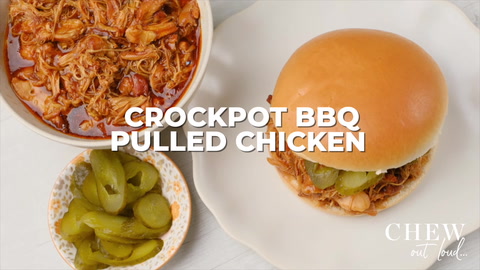Sopressata: The Bold and Flavorful Tradition of Italian Cured Meat
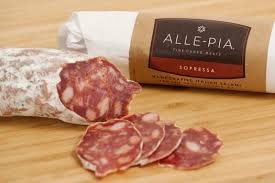
Introduction
Italian cuisine is known around the world for its bold flavors, regional variety, and commitment to quality ingredients. Among the many delicacies that define Italian culinary culture, sopressata stands out as a cherished staple. This rustic, dry-cured salami is packed with flavor, rich in history, and beloved by food enthusiasts who crave artisanal meats with character.
In this article, we explore everything you need to know about sopressata—its origins, regional differences, preparation methods, how it’s enjoyed, and why it continues to be one of Italy’s most iconic cured meats. Whether you’re planning a charcuterie board or simply expanding your food knowledge, the story of sopressata is as satisfying as its taste.

1. What Is Sopressata?
Sopressata is a type of Italian salami made from coarsely ground pork, seasoned with spices, and dry-cured over weeks or months. Unlike typical salami, sopressata is often pressed, giving it a flatter and more oblong shape. The name comes from the Italian word “soppressare,” which means “to press.” This pressing is what gives sopressata its distinctive texture and appearance.
Although traditionally made with pork, modern variations of sopressata can include beef or even turkey, especially in the United States. However, authentic Italian sopressata typically remains rooted in pork, with recipes passed down through generations.
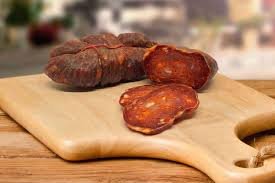
2. The History of Sopressata
The roots of sopressata go back centuries to rural Southern Italy. Regions like Calabria, Basilicata, Puglia, and Molise developed their own versions based on available spices, climate, and local techniques. For these communities, sopressata was not only a means of preserving meat without refrigeration but also a symbol of culinary pride.
Every year after the pig slaughter, families would gather to make sopressata, often using the finest cuts of pork like shoulder, ham, and sometimes fatback. Seasoned with salt, pepper, garlic, and occasionally chili flakes or wine, the mixture was stuffed into natural casings, pressed, and then hung to dry in cool, ventilated areas.
Over time, sopressata became more than a preservation method—it became a tradition and an essential part of southern Italian identity.

3. Regional Varieties of Sopressata
The beauty of sopressata lies in its regional diversity. Different areas of Italy—and even immigrant communities abroad—have created unique interpretations of this cured meat.
Sopressata di Calabria
This is perhaps the most well-known version. It’s spicy, bold, and made with Calabrian chili flakes, garlic, and black pepper. The Calabrian climate is ideal for air curing, and the result is a deep red sopressata with fiery flavor.
Sopressata di Basilicata
Milder than its Calabrian cousin, this version focuses on herbs and subtle seasoning. You’ll find notes of garlic and fennel, with a smoother taste and slightly softer texture.
Sopressata di Puglia
Often smoked and aged longer, the Pugliese version of sopressata is firm and savory. Some recipes even incorporate wine or paprika for added depth.
Sopressa Veneta (from Veneto)
Although spelled slightly differently, Sopressa from Northern Italy is often softer and flavored with nutmeg, cinnamon, and other aromatic spices. It’s less spicy but just as rich in character.
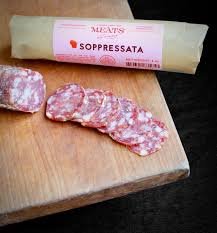
4. How Sopressata Is Made
The traditional method of making sopressata involves several key steps:
- Meat Selection
High-quality pork is selected, often including shoulder, ham, and pork belly. The meat is coarsely chopped by hand or machine. - Seasoning
Salt, black pepper, garlic, and chili flakes (especially in southern versions) are added. Some recipes include wine or vinegar. - Stuffing and Pressing
The seasoned meat is packed into natural casings. Then, it is pressed between wooden planks or in molds to remove air and flatten the shape—hence the name sopressata. - Drying and Aging
The salami is hung in cool, dry rooms and cured for 30 to 90 days, depending on size and regional style. - Final Inspection
Once cured, the sopressata is checked for consistency, flavor, and texture. A properly made sopressata should be firm, richly seasoned, and slightly chewy.
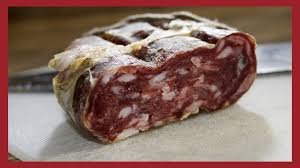
5. How Sopressata Tastes
The flavor of sopressata depends on the region, seasoning, and curing time. Most sopressata has a bold, pork-forward taste with spicy, garlicky undertones. The texture is coarse and rustic, allowing the natural flavors of the meat to shine.
In southern varieties like Calabrian sopressata, expect a strong kick of heat from chili peppers. In northern versions, expect milder, aromatic notes.
The balance of fat and lean meat gives sopressata a rich mouthfeel, while the pressing process makes each slice dense and satisfying.

6. Sopressata vs. Salami
Many people confuse sopressata with generic salami, but the two are quite different.
| Feature | Sopressata | Salami |
|---|---|---|
| Shape | Pressed, flat | Round |
| Texture | Coarse | Fine to medium grind |
| Flavor | Bold, spicy, rustic | Mild or tangy |
| Curing | Longer and more traditional | Varies |
| Common Regions | Calabria, Puglia, Basilicata | Nationwide |

7. How to Enjoy Sopressata
Sopressata is incredibly versatile and can be used in a variety of dishes:
- Charcuterie Boards
Pair sopressata with cheeses like Pecorino or Parmigiano, nuts, olives, and crusty bread for an elevated appetizer. - Sandwiches
Layer it on a ciabatta roll with arugula, provolone, and a drizzle of olive oil. - Pizza Topping
Add thin slices of sopressata to your homemade pizza for a spicy upgrade. - Pasta Dishes
Chop and sauté sopressata into pasta for a savory, meaty addition. - Omelets and Frittatas
For breakfast lovers, dice some sopressata into eggs for a bold flavor boost.

8. Nutritional Information
Per 1-ounce serving, sopressata typically contains:
- Calories: 130–150
- Protein: 6–8g
- Fat: 11–13g
- Sodium: 450–600mg
- Carbohydrates: 0g
It’s keto-friendly and high in protein, but because of its sodium and fat content, sopressata is best enjoyed in moderation.

9. Storage and Shelf Life
Properly stored sopressata can last for weeks or even months. Here’s how to keep it fresh:
- Unopened: Vacuum-sealed sopressata can be stored in a cool pantry for several months.
- Opened: Wrap tightly in plastic or butcher paper and refrigerate. Use within 2–3 weeks for the best flavor.
- Frozen: While not ideal, sopressata can be frozen. Wrap in plastic and then foil, and store for up to 3 months.

10. Where to Buy Sopressata
You can find sopressata at Italian delis, specialty grocery stores, or online. Look for artisanal producers who use traditional methods and high-quality pork. Imported sopressata from Italy will often be labeled with PDO (Protected Designation of Origin) for authenticity.

11. Why You Should Try Sopressata
Still wondering whether sopressata is worth trying? Here’s why you should:
- Flavor: Rich, savory, and often spicy—no other salami quite matches it.
- Tradition: It’s a bite of Italy’s rural history.
- Versatility: Works with everything from charcuterie to hot dishes.
- Shelf-Life: Long-lasting and travel-friendly.

Conclusion
Whether you’re an Italian food purist or just someone who loves cured meats, sopressata deserves a spot in your kitchen. This bold and flavorful salami connects you to centuries of tradition and offers an experience that is as cultural as it is culinary.
From its rustic origins in Southern Italy to its place on modern charcuterie boards, sopressata continues to impress food lovers with its richness, versatility, and unmistakable flavor. So next time you’re shopping for artisanal meats, don’t forget to reach for the sopressata—you won’t be disappointed.





